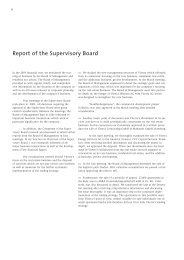E_mg_GB_03_vorne-29_3_04
E_mg_GB_03_vorne-29_3_04
E_mg_GB_03_vorne-29_3_04
You also want an ePaper? Increase the reach of your titles
YUMPU automatically turns print PDFs into web optimized ePapers that Google loves.
154<br />
Deferred taxes<br />
Section 306 of the H<strong>GB</strong> states that deferred taxes must be recognized for all temporary differences<br />
between the carrying amounts in the tax accounts and those reported in the consolidated financial<br />
statements (timing concept); they are computed at the current tax rate. This recognizes timing differences<br />
between the tax accounts and the statutory financial statements (financial statements I) as<br />
well as the financial statements prepared for inclusion in the consolidated accounts (financial statements<br />
II). The effects of consolidation measures that are subsequently reversed over the course of<br />
time also have to be recognized. The H<strong>GB</strong> does not permit deferred taxes to be recognized for either<br />
quasi-permanent differences or losses carried forward.<br />
U.S. GAAP (SFAS 109 ‘Accounting for Income Taxes’) state that deferred taxes have to be recognized<br />
for temporary differences arising between the tax bases of assets or liabilities and their carrying<br />
amounts in the consolidated financial statements, with quasi-permanent differences being classified<br />
as temporary (temporary concept). As under the H<strong>GB</strong>, this recognizes differences between the tax<br />
accounts and financial statements I and II and the effects of consolidation measures. Unlike the H<strong>GB</strong>,<br />
it only recognizes such differences if they are temporary. Additionally, deferred taxes are recognized<br />
on net operating loss (NOL) carryforwards to the extent that their future tax benefit or utilization<br />
can be realized. Tax is computed at the rate applicable under current law to retained earnings at the<br />
balance sheet date, taking account of future known changes to the tax rate. If deferred tax assets<br />
are unlikely to be realized, a valuation allowance is reported.<br />
Other Provisions and Accruals<br />
In addition to the requirement to report provisions for liabilities and impending losses pursuant to<br />
section 249 (I), the H<strong>GB</strong> also states that provisions and accruals may be recognized for certain<br />
expenses that do not constitute an obligation toward a third party (expense provisions pursuant to<br />
section 249 (II) of the H<strong>GB</strong>). Provisions and accruals are calculated pursuant to section 253 (I) of<br />
the H<strong>GB</strong> in accordance with customary commercial principles and the prudence principle.<br />
The reporting of provisions and accruals under U.S. GAAP (CON 6 ‘Elements of Financial Statements’<br />
and SFAS 5 ‘Accounting for Contingencies’) is much more restrictive. Accruals and provisions may only<br />
be established if an obligation toward a third party exists, there is a likelihood of its crystallization<br />
and its amount can be reasonably estimated. Expense provisions are not permitted. When such provisions<br />
and accruals are accounted for, the most probable value is reported; if there is a range of<br />
equally probable values, the lowest one is reported.<br />
Provisions and accruals for losses on long-term contracts have to be recognized in full under U.S.<br />
GAAP – as they do under the H<strong>GB</strong> – in the period in which such losses become apparent. Under<br />
U.S. GAAP, however, provisions are formed on the basis of total estimated residual costs, including<br />
all production-related costs in full.









